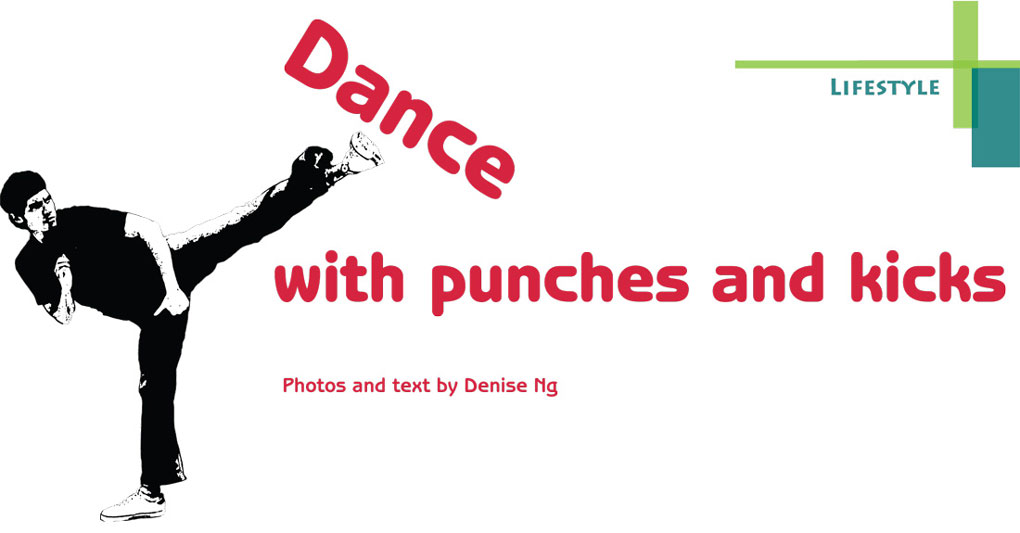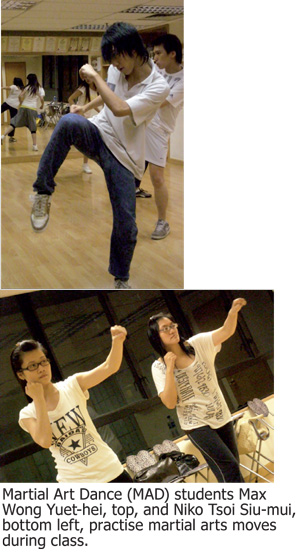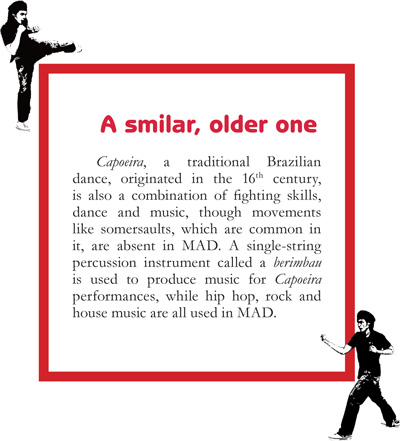
 Reflected from the wall mirrors of the dance studio are not fast jazz funk moves or elegant ballet steps. High kicks in the air and hard-hitting punches are in the groove with hip hop dance moves.
Reflected from the wall mirrors of the dance studio are not fast jazz funk moves or elegant ballet steps. High kicks in the air and hard-hitting punches are in the groove with hip hop dance moves.
The players are in T-shirts and pants instead of the traditional white kung fu uniforms as they practised Martial Art Dance (MAD), a fast-growing craze in Hong Kong, combining different kinds of martial art and dance.
While traditional martial art practitioners do not move with rhythms, MAD players move along with strong beats of popular music.
Max Wong Yuet-hei, 17, has been taking MAD classes offered by the Hong Kong Martial Art Dance Club for around two years. He had previously learned modern martial arts including taekwondo, karate, aikido and judo.
He said that traditional martial arts are comparatively hard since they are about how to attack and defend.
“MAD intertwines toughness and flexibility,” said Wong, adding that he likes MAD more because it is more diverse by adding in the elements of dance and music to martial arts.
But experiences in hip hop dance or martial arts are not a prerequisite for taking up MAD.
In MAD classes, students are not required to learn all the different kinds of martial art and dance in the same lesson.
Beginners are only taught basic kung fu moves like punches, kicks, elbows and knees for attacking moves. On the other hand, they have to learn fundamental hip hop moves like locking, popping, and house dance separately.
Another MAD practitioner, Amy Cheung Ching-kwan, had not learnt anything about martial arts or hip hop dance before she took up MAD four months ago. She said she could easily catch up because the instructor only taught basic moves like kicking and punching at the beginning so she could easily follow.
Cheung also said she enjoys the lessons very much because she likes listening to English songs, which are often used in MAD training and performances.
Niko Tsoi Siu-mui said she could enjoy both martial art and hip hop dance simultaneously with MAD, and has been taking classes for nine months.
Yet, she has achieved more than what she set out to do with MAD as she voluntarily took part in her first performance, the “Elvisly MAD Show” in a pub called Jardin House in Central this year.
According to Khasman Khan, founder and director of the Hong Kong Martial Art Dance Club, MAD is more than a sport.
“MAD also means ‘make a difference’,” said Khan. “It is the quintessence of the combination of tradition and innovation”.
Such a fusion of traditional martial arts and hip hop elements in MAD apparently echo with the mixed blood identity of Khan, who is half Chinese and half Pakistani.
According to the 21-year-old, he loves many kinds of martial art and dance. He has a black belt from the Modern Martial Arts Academy and over eight years of experience in martial arts. While he has been learning hip hop dance for about four years, he has also been learning Thai boxing recently.
He said he once wondered whether people with basic martial art training would learn dancing better or not.
“The answer is no,” he said, adding that martial art helps the body to stretch better and become more nimble. “Dancing emphasises one’s sense of rhythm and helps the coordination of different parts of the body,” he explained.
Khan also recalled that at times he would do some hip hop moves unintentionally when he was playing martial arts. The same happened while he was dancing, as he would do some fighting moves as well.
That was when he started to create MAD by merging the two different kinds of exercise. He founded the Hong Kong Martial Art Dance Club in March last year.
Khan is the only MAD instructor at the dance club. There are no rigid rules for MAD. But Khan has set up a 10-level examination system for it.
 Students are expected to compose a new MAD piece used for performance in the higher level examinations. It takes a student at least one-and-a-half years to go all the way to level 10.
Students are expected to compose a new MAD piece used for performance in the higher level examinations. It takes a student at least one-and-a-half years to go all the way to level 10.
Khan has also established four colour themes to represent his idea of the sport. The four colours, red, blue, white and black, symbolise tradition, harmony, innovation and power respectively.
He has published the first comic book about MAD, Let’s Get Mad, which was produced by art-loving members of the dance club. In early August, 10, 000 copies were distributed at the Animation-Comic-Game Hong Kong 2008 Fair. Four to five young people were attracted to join the trial classes.
Another fusion of dance and Korean martial arts, taekwondo dance, however has not taken off in Hong Kong because some people saw it as losing elements of the traditional martial art, according to a veteran taekwondo instructor.
Yau Chin-wah, vice-curator of Hong Kong Taekwondo Jung Do Kwan, who has been learning and teaching taekwondo for more than 30 years, said that MAD is similar to poomsae, or patterns, which are a series of movements for physical practice in taekwondo. However, MAD is more flexible and softer than other martial arts such as taekwondo and karate.
Rock Fang Kar-naught, a hip hop dance instructor with seven years of teaching experience, said he supports the idea of combining martial arts and dances, but the most important matter is whether such a fusion can fully show the strengths of both art forms.
“It is highly feasible to combine martial arts and dancing because there is no limitation for creativity,” Fang said, but added that MAD players performed dance moves such as locking, popping and house-dance moves, but they failed to express the emotions for such moves.
He said the reason for the loss of emotion in the dance moves lay with the music which was played when doing MAD. He suggested MAD players pick music that could link up both the martial arts and dance moves smoothly. 
